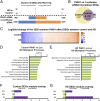PIAS1 modulates striatal transcription, DNA damage repair, and SUMOylation with relevance to Huntington's disease
- PMID: 33468657
- PMCID: PMC7848703
- DOI: 10.1073/pnas.2021836118
PIAS1 modulates striatal transcription, DNA damage repair, and SUMOylation with relevance to Huntington's disease
Erratum in
-
Correction for Morozko et al., PIAS1 modulates striatal transcription, DNA damage repair, and SUMOylation with relevance to Huntington's disease.Proc Natl Acad Sci U S A. 2021 Aug 10;118(32):e2112001118. doi: 10.1073/pnas.2112001118. Proc Natl Acad Sci U S A. 2021. PMID: 34341126 Free PMC article. No abstract available.
Abstract
DNA damage repair genes are modifiers of disease onset in Huntington's disease (HD), but how this process intersects with associated disease pathways remains unclear. Here we evaluated the mechanistic contributions of protein inhibitor of activated STAT-1 (PIAS1) in HD mice and HD patient-derived induced pluripotent stem cells (iPSCs) and find a link between PIAS1 and DNA damage repair pathways. We show that PIAS1 is a component of the transcription-coupled repair complex, that includes the DNA damage end processing enzyme polynucleotide kinase-phosphatase (PNKP), and that PIAS1 is a SUMO E3 ligase for PNKP. Pias1 knockdown (KD) in HD mice had a normalizing effect on HD transcriptional dysregulation associated with synaptic function and disease-associated transcriptional coexpression modules enriched for DNA damage repair mechanisms as did reduction of PIAS1 in HD iPSC-derived neurons. KD also restored mutant HTT-perturbed enzymatic activity of PNKP and modulated genomic integrity of several transcriptionally normalized genes. The findings here now link SUMO modifying machinery to DNA damage repair responses and transcriptional modulation in neurodegenerative disease.
Keywords: DNA damage repair; Huntington's disease; PIAS; PNKP; SUMO.
Copyright © 2021 the Author(s). Published by PNAS.
Conflict of interest statement
The authors declare no competing interest.
Figures





Similar articles
-
A PIAS1 Protective Variant S510G Delays polyQ Disease Onset by Modifying Protein Homeostasis.Mov Disord. 2022 Apr;37(4):767-777. doi: 10.1002/mds.28896. Epub 2021 Dec 23. Mov Disord. 2022. PMID: 34951052
-
PIAS1 Regulates Mutant Huntingtin Accumulation and Huntington's Disease-Associated Phenotypes In Vivo.Neuron. 2016 May 4;90(3):507-20. doi: 10.1016/j.neuron.2016.03.016. Epub 2016 Apr 14. Neuron. 2016. PMID: 27146268 Free PMC article.
-
Dysregulation of protein SUMOylation networks in Huntington's disease R6/2 mouse striatum.Brain. 2025 Apr 3;148(4):1212-1227. doi: 10.1093/brain/awae319. Brain. 2025. PMID: 39391934 Free PMC article.
-
The role of Rhes, Ras homolog enriched in striatum, in neurodegenerative processes.Exp Cell Res. 2013 Sep 10;319(15):2310-5. doi: 10.1016/j.yexcr.2013.03.033. Epub 2013 Apr 10. Exp Cell Res. 2013. PMID: 23583659 Review.
-
Cellular Models: HD Patient-Derived Pluripotent Stem Cells.Methods Mol Biol. 2018;1780:41-73. doi: 10.1007/978-1-4939-7825-0_4. Methods Mol Biol. 2018. PMID: 29856014 Review.
Cited by
-
Loss of TDP-43 mediates severe neurotoxicity by suppressing PJA1 gene transcription in the monkey brain.Cell Mol Life Sci. 2024 Jan 9;81(1):16. doi: 10.1007/s00018-023-05066-2. Cell Mol Life Sci. 2024. PMID: 38194085 Free PMC article.
-
Hydrogen Sulfide: A Versatile Molecule and Therapeutic Target in Health and Diseases.Biomolecules. 2024 Sep 10;14(9):1145. doi: 10.3390/biom14091145. Biomolecules. 2024. PMID: 39334911 Free PMC article. Review.
-
SUMOylation of Rho-associated protein kinase 2 induces goblet cell metaplasia in allergic airways.Nat Commun. 2023 Jul 1;14(1):3887. doi: 10.1038/s41467-023-39600-4. Nat Commun. 2023. PMID: 37393345 Free PMC article.
-
SUMOylation targeting mitophagy in cardiovascular diseases.J Mol Med (Berl). 2022 Nov;100(11):1511-1538. doi: 10.1007/s00109-022-02258-4. Epub 2022 Sep 26. J Mol Med (Berl). 2022. PMID: 36163375 Review.
-
SUMO-modifying Huntington's disease.IBRO Neurosci Rep. 2022 Mar 9;12:203-209. doi: 10.1016/j.ibneur.2022.03.002. eCollection 2022 Jun. IBRO Neurosci Rep. 2022. PMID: 35746980 Free PMC article. Review.
References
-
- The Huntington’s Disease Collaborative Research Group , A novel gene containing a trinucleotide repeat that is expanded and unstable on Huntington’s disease chromosomes. Cell 72, 971–983 (1993). - PubMed
-
- Langbehn D. R., Brinkman R. R., Falush D., Paulsen J. S., Hayden M. R.; International Huntington’s Disease Collaborative Group , A new model for prediction of the age of onset and penetrance for Huntington’s disease based on CAG length. Clin. Genet. 65, 267–277 (2004). - PubMed
Publication types
MeSH terms
Substances
Grants and funding
LinkOut - more resources
Full Text Sources
Other Literature Sources
Medical
Molecular Biology Databases
Research Materials
Miscellaneous

